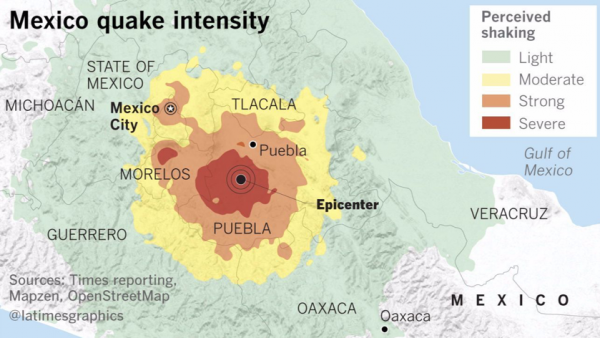Prepared by Ezra Jampole, Sahar Derakhshan, and Matthew Bandlet
At 2:14 pm Eastern Time on September 19, 2017 a M7.1 earthquake hit near Puebla, Mexico causing damage to Mexico City, Morelos state, Puebla state, Mexico state, Guerrero, and Oaxaca [LA Times]. The current estimates show that approximately 320 people have died due to the earthquake and thousands of structures have been destroyed or affected [NY Daily News]. In the aftermath of the earthquake it has been observed that the most structural damage occurred to smaller structures, 1-5 stories, because of the proximity to the earthquake as well as the soft soil that amplified the earthquake resonance by up to 100 times. The typical structures that experiences critical failure were made from under reinforced concrete or unreinforced masonry. Taller buildings tended to fare better because the regulations that were put in place after the 1985 earthquake that hit Mexico [LA Times]. In general it seems that mostly smaller residential buildings were affected by the earthquake, which is believed to be part of the reason for a relatively low death toll [NY Times], however there were several commercial buildings affected such as office buildings and at least one school [Vox].
 |
| Figure 1. Earthquake Intensity. Source: LA Times. |
Many of the citizens interviewed after the earthquake noted that there has been a relatively low involvement by the government for the cleanup effort. Other than some military aid the majority of the effort has been from either civilians trying to clean up their homes, volunteers coming to help, and organizations such as the Red Cross. [ABC] [Red Cross]. There have also been criticisms of the lack of inspection and enforcement of the new building codes during construction [NY Times]. Essentially, the main reason that most of the taller buildings fared so well in this earthquake compared to the earthquake experienced in 1985 is because of the location of the source of the earthquake and the resulting resonance that occurred in the affected cities [LA Times].
 |
 |
| Figure 2. Crew clearing rubble after earthquake. Source: International Business Times. | Figure 3. Typical building type damaged. Source: NY Times |
Ezra Jampole, Matthew Bandelt, and Sahar Derakhshan will be curating the housing topic of EERI’s Puebla, Mexico earthquake Clearinghouse. Dr. Jampole is an Associate at Exponent in New York City, where he investigates structural engineering failures, and an Adjunct Professor at the New Jersey Institute of Technology. Dr. Bandelt is an Assistant Professor at New Jersey Institute of Technology, where he conducts research on the structural performance of emerging infrastructure materials for durability and natural hazards applications, and teaches undergraduate and graduate courses in reinforced concrete. Ms. Derakhshan is a Research Associate at the Hazards and Vulnerability Research Institute (HVRI) at the University of South Carolina with backgrounds in public policy and structural engineering.